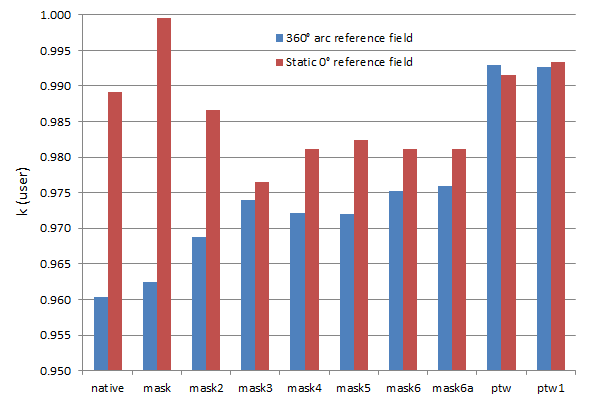Results (2)
Cross-calibration: Static versus Arc Reference
The following bar chart shows static (red) and arc (blue) k(user) factors for the eight KFJ structure sets and the PTW data set. Data is for 10 MV and AAA11031. All structure sets contain the thin Exact IGRT couch for the arc plans.

(Fig.18: Cross-calibration factors resulting from measurements of static and arc reference fields.)
The difference between the structure sets "ptw" and "ptw1" is a small shift of field isocenter (and plane of dose export): "ptw" uses the original location as contained in the download data, whereas "ptw1" has the isocenter shifted upstream by 1 mm (chamber center). The latter is consistent with the KFJ structure sets.
In contrast to the static reference field, the arc reference field "probes" the effect of the dense OD backplane and the couch. Imperfections in Eclipse couch modelling would influence the arc reference k(user).
Ideally, it should not matter which type of reference field is used: static and arc should give the same k(user). This is no problem for the water equivalent S29 in the PTW structure sets, but nearly impossible for the OD in the KFJ sets. The chart clearly demonstrates the dosimetric problems which were introduced by selecting bone-like high density materials for the OD.
One can also interpret the arc reference field as a (very simple) 360°-RapidArc field. If the physicist chooses the native set and performs the verification based on a static 0° reference field, he will get a near 3% deviation.
Due to the fact that a 360° arc reference probes the tandem from all sides, the differences in verification results between the various structure sets will be lower for the arc reference than for the static reference, where k(user) is determined at 0° alone.
To save time, it is no necessary to measure a full arc reference field in every verification session. Considering the warm-up time of the OD and that it needs at least three full arcs until the readings are stable, this can save several minutes. Fig.18 can be used to convert from a (measured) static reference k(user) to a (calculated) arc reference k(user), and apply the latter for the actual verification. For a certain energy and reference field size, the relation between static and arc reference is fixed.
Fig.18 shows only one aspect (0° versus full arc). The gantry angle dependence for the nine structure sets is the next refinement.